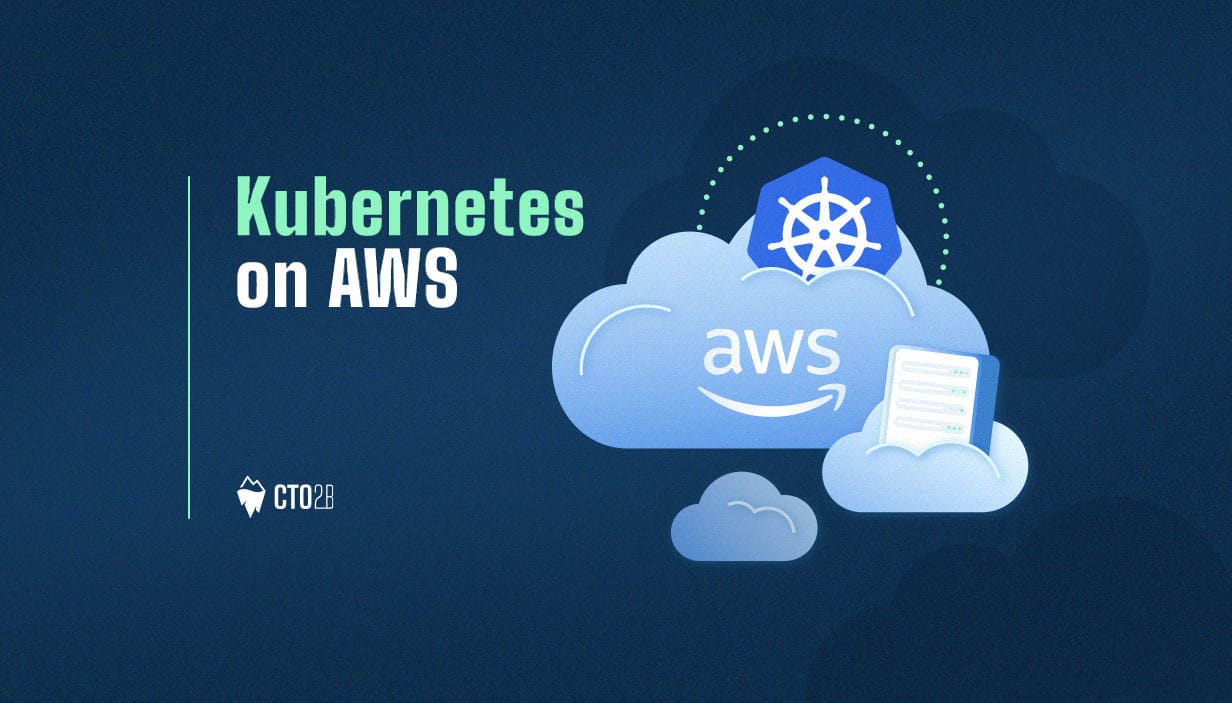Kubernetes has become the standard for orchestrating containerized applications at scale. When combined with Amazon Web Services (AWS), it unlocks powerful features for scalability, automation, and resilience. There are several solutions for running Kubernetes on AWS, including Amazon EKS, EC2 as a virtual server, and Infrastructure as Code (IaC), each suited to a specific use case. This article explains the main ways to run Kubernetes on AWS (using Amazon EKS, manual EC2 deployments, and IaC) and covers security, cost, and ongoing operations and management best practices.
Amazon EKS is a simple solution for deploying Kubernetes that includes managed features such as the Kubernetes control plane, making it easy to create and manage a cluster with EKS. EC2 provides a virtual server solution for running Kubernetes, which can be contrasted with on-premises (premises) deployments. When deploying Kubernetes, workloads can be scheduled within the cluster to optimize resource usage and application performance.
Why Run Kubernetes on AWS?
Pairing Kubernetes with AWS brings several advantages:
- Scalability: Effortlessly scale clusters to meet demand.
- Portability: Deploy workloads across different environments with minimal changes.
- High Availability: Benefit from AWS’s multi-zone infrastructure.
- Cost Efficiency: Use auto-scaling to optimize resources and spending.
- Integration: Seamlessly connect with AWS services like VPC, IAM, and Elastic Load Balancer.
For organizations seeking a holistic approach to managing and optimizing their environments, cloud infrastructure management is a foundational strategy.
Introduction to Kubernetes on AWS
Kubernetes is an open-source platform that automates the deployment, scaling, and management of containerized applications, making it a powerful tool for organizations looking to modernize their infrastructure. Kubernetes lets teams orchestrate complex workloads with ease, ensuring applications remain reliable and scalable even as demand changes. When you deploy Kubernetes on AWS infrastructure, you benefit from Amazon’s robust cloud environment, which offers high availability, fault tolerance, and seamless integration with a wide range of AWS services. You can learn more by reading our Kubernetes for beginners article.
There are different ways to deploy Kubernetes on AWS, each suited to various use cases and organizational needs. This article will guide you through the main approaches such as using Amazon EKS for managed clusters, running Kubernetes directly on EC2 instances for maximum control, and leveraging Infrastructure as Code (IaC) tools for automation and repeatability. By understanding these options, you can make informed decisions about how to deploy Kubernetes in a way that best supports your applications and business goals, making management and scaling simpler and more efficient.
Kubernetes Deployment Options on AWS
Option 1: Using Amazon Elastic Kubernetes Service (EKS)
Amazon EKS is a fully managed Kubernetes service, making it easy to deploy, scale, and operate clusters without managing the control plane yourself. You can quickly create and manage a cluster with EKS, which includes automation and integrations for cluster operations.
Key Features:
- Control plane managed by AWS and distributed across multiple zones.
- EKS manages the Kubernetes control plane, automating provisioning, scaling, and security updates.
- Worker nodes run on EC2 or Fargate.
- Built-in integrations with AWS networking, security, and storage.
How to Deploy:
- AWS Console: Create a VPC, IAM role, and then use the EKS dashboard to launch a cluster and add worker nodes. Start by searching for EKS in the AWS Management Console, and searching for the EKS dashboard to begin setup.
- CLI (eksctl): Install eksctl and AWS CLI. With a single command, you can spin up a new cluster:
eksctl create cluster –name mycluster –region us-west-2 –nodes 3- Update kubeconfig: Use the AWS CLI to update your kubeconfig file so you can interact with the cluster using kubectl.
- Join worker nodes: Add or join worker nodes to your cluster to ensure proper operation and management.
- Find troubleshooting info: If you encounter issues, you can find troubleshooting information by searching the AWS documentation or within the AWS console.
Pros: Quick setup, managed upgrades, integrated security.
Cons: Less control over the control plane, some manual steps for advanced setups.
To further accelerate deployments and boost team efficiency, consider adopting DevOps automation.
Option 2: Manual Kubernetes Installation on EC2
Running Kubernetes directly on EC2 gives you complete control over your environment, including the choice of Kubernetes distribution and system configuration. An EC2 instance is a virtual server provided by AWS, allowing you to host applications with scalable resources. Deploying Kubernetes on EC2 differs from running it on on-premises (premises) infrastructure, as it leverages cloud flexibility instead of physical on-site data centers.
How to Set Up:
- Launch EC2 instances for master and worker nodes.
- Install Kubernetes (via kubeadm, K3s, or Minikube).
- Configure networking, security, and storage manually.
Pros: Maximum customization and control.
Cons: High operational overhead, manual upgrades, and scaling.
If your organization is planning a move to the cloud or modernizing legacy systems, cloud migration can help smooth the transition.
Option 3: Infrastructure as Code (IaC) Automation
IaC tools like Terraform let you define Kubernetes clusters and AWS resources as code, ensuring consistency and repeatability.
Workflow:
- Write Terraform scripts for EKS or EC2 resources.
- Configure Terraform for local use to manage infrastructure files and provision clusters without a Terraform Cloud account.
- Use version control for infrastructure.
- Manage and track the current state of your infrastructure using Terraform state files, which are essential for consistent updates and management.
- Deploy clusters automatically via CI/CD.
Benefits: Consistent, repeatable deployments, streamlined ongoing operations and management, and easier collaboration.
As your infrastructure grows, it’s crucial to keep costs under control. Cloud cost optimization offers strategies and tools to help you maximize value.
Cluster Creation and Management
Creating a Kubernetes cluster on AWS is streamlined with Amazon EKS, which handles the control plane and simplifies cluster management. To get started, log in to the AWS Management Console and initiate the creation of a new cluster. During this process, you’ll define essential settings such as the cluster name, region, and networking configuration. Assigning IAM roles is a crucial step as these roles grant the necessary permissions for both the cluster itself and the worker nodes that will run your workloads.
Next, configure your node group by selecting the EC2 instance type and specifying how many nodes you want in your cluster. Adding more nodes increases your cluster’s capacity and fault tolerance, but it’s important to balance this with cost considerations. Once your cluster is created, you can connect to it using the AWS CLI and kubectl, allowing you to manage workloads and resources directly.
Amazon EKS also supports auto scaling, which automatically adjusts the number of nodes in your cluster based on resource utilization. This ensures your applications have the resources they need during peak times, while optimizing costs during periods of lower demand. With these management features, you can maintain a resilient and efficient Kubernetes environment on AWS.
Data Plane Configuration and Optimization
The data plane in a Kubernetes cluster is responsible for handling network traffic between pods and ensuring efficient communication across your workloads. On AWS, you can optimize the data plane by integrating services like Elastic Load Balancer (ELB) and Amazon Route 53. ELB distributes incoming application traffic across multiple worker nodes, enhancing both reliability and scalability. By leveraging Amazon Route 53, you can manage DNS records and intelligently route user requests to the appropriate ELB endpoints, ensuring high availability and low latency.
Kubernetes services can be configured to work seamlessly with these AWS offerings, allowing you to fine-tune how traffic flows within your cluster. Optimizing the data plane not only improves application performance but also supports fault tolerance and smooth scaling as your workloads grow. By taking advantage of these AWS tools, you ensure your Kubernetes cluster is ready to handle production workloads with maximum efficiency.
Security Best Practices for Kubernetes on AWS
Security is critical in any cloud deployment:
- IAM Roles & Policies: Assign least-privilege permissions for cluster resources.
- Network Security: Use security groups and network policies to restrict traffic.
- Secrets Management: Store sensitive data with AWS Secrets Manager.
- Monitoring & Logging: Enable CloudWatch and CloudTrail for visibility.
- Pod Security: Avoid privileged containers and enforce least privilege.
For organizations with regulatory requirements, cloud compliance is essential to ensure your clusters meet industry standards.
Monitoring, Logging, and Automation Tools
Robust monitoring and automation help maintain healthy clusters:
- Monitoring: Amazon CloudWatch, Prometheus
- Logging: CloudWatch Logs, Elasticsearch
- Automation: Terraform, AWS CloudFormation, CI/CD pipelines
Troubleshooting Common Issues
Common issues when running Kubernetes on AWS include:
- Resource Limits: Ensure pods and nodes have enough CPU and memory.
- Network Configuration: Check VPC, subnets, and security group settings.
- Security Groups: Open required ports for cluster communication.
- Upgrades: Plan and test version upgrades before applying.
Case Studies & Practical Examples
- Manual EC2: Enterprises with strict compliance needs often opt for manual deployments.
- EKS: Startups and tech companies benefit from reduced overhead and rapid scaling.
- IaC Automation: Teams managing multiple clusters value repeatability and safety.
Choosing the Right Approach
The right method for running Kubernetes on AWS depends on your need for control, compliance, and scalability. EKS is ideal for most organizations seeking simplicity, while manual EC2 deployments suit those needing granular control. IaC automation is best for teams managing infrastructure at scale.

Eliminate unnecessary resources, & enhance fault tolerance with enterprise-grade tools.
FAQs
What is the difference between EKS and manually running Kubernetes on EC2?
EKS is a fully managed Kubernetes service provided by AWS, which means AWS handles the control plane, scaling, updates, and availability. In contrast, running Kubernetes on EC2 requires you to manage the entire setup yourself, including the control plane, worker nodes, upgrades, and maintenance.
Is Kubernetes free to use on AWS?
Kubernetes itself is open-source and free, but when using it on AWS — especially through EKS — you pay for the EKS control plane and the underlying AWS resources (such as EC2 instances, load balancers, and storage) that your cluster consumes.
How do I estimate the cost of running Kubernetes on AWS?
You can estimate costs using the AWS Pricing Calculator by accounting for both the EKS control plane charges and the EC2 node costs. It’s also important to monitor actual usage over time to avoid unexpected expenses.
What are the security best practices for Kubernetes on AWS?
Follow best practices such as implementing IAM roles for service accounts, defining network policies, managing secrets securely (e.g., using AWS Secrets Manager), enabling logging and audit trails, and applying regular security patches to your worker nodes.
Can I automate Kubernetes cluster deployment on AWS?
Yes, you can automate cluster creation and configuration using Infrastructure as Code (IaC) tools like Terraform or AWS CloudFormation, often integrated with CI/CD pipelines for continuous deployment and updates.
What tools can help monitor and manage Kubernetes clusters on AWS?
Popular tools include Amazon CloudWatch for metrics and logs, Prometheus for detailed Kubernetes monitoring, and CloudWatch Logs for centralized log collection and analysis.
How do I troubleshoot common Kubernetes issues on AWS?
Start by checking resource limits (CPU, memory), reviewing network configurations, inspecting security group settings, and analyzing pod and node logs. AWS tools like CloudWatch and the EKS console can help identify bottlenecks or errors.

